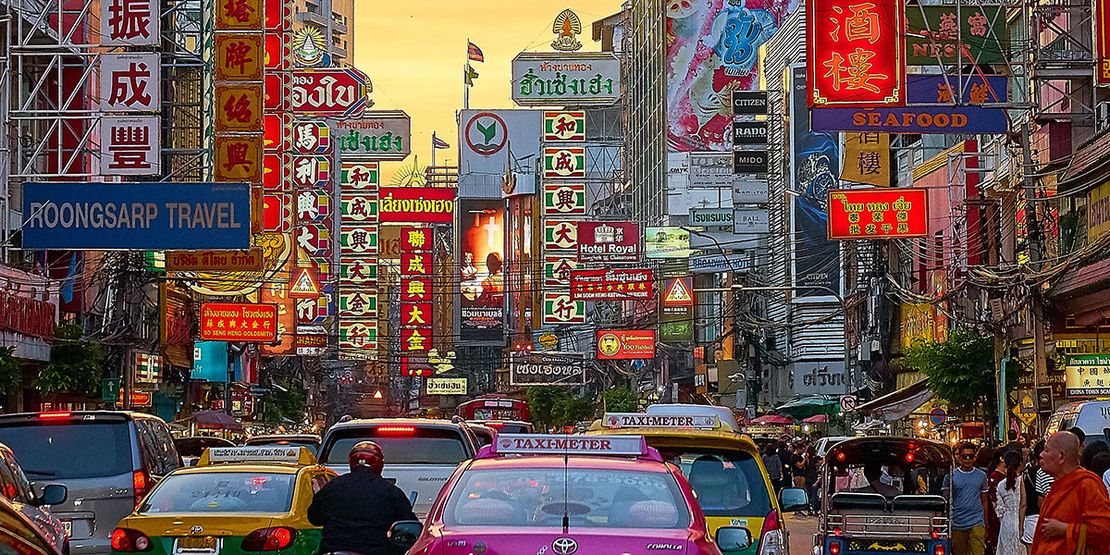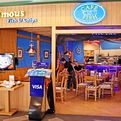Chinese History in Bangkok: A Captivating Guide
Chinese influence is everywhere in Krung Thep Maha Nakhon (Bangkok) and has permeated every part of Thai society, but how did that come about, and where did it all start? 🧐
If you know your Southeast Asian history or have lived in Thailand for some years, you will already know the Chinese role in Thailand over the past few hundred years.
To learn more about Chinese history in Krung Thep Maha Nakhon (Bangkok), make sure to read this captivating guide to the end 👓
Early History of Chinese in Thailand
Even though it is thought that Chinese influence in Thailand started in the 1800s, it goes back much longer than that 🎓 A famous 15th Chinese explorer who was also a eunuch, Zheng Ho, said that even when he visited Thailand, which was then known as Siam, there were Chinese already living there because women were plentiful as there were a large number of monks in Siam 🧐 Whether or not the reports were accurate, it shows that Chinese influence in Siam has been prominent for hundreds of years.
Moving to more modern times, thousands of Chinese immigrants from Southern China settled in Siam. They had a massive impact on developing the new Thai capital city in 1782, which became Bangkok 👓, or its local name, Krung Thep Maha Nakhon. Bangkok’s Chinatown was born, which is currently known as ‘Yaowarat’, is one of the largest Chinatowns in the world.
With one of the largest communities of Chinese outside of China, Yaowarat is sandwiched 📎 between the Krung Kasem Canal and the Chao Phraya River. Even today, Bangkok’s Chinatown is one of the most-visited parts of the city and wows visitors with its temples and colorful markets, gold shops, and warehouses 🧐 The area has played a massive role in trade between China and Thailand over the past 200 years.
Thai Chinese are the largest minority group in Thailand, making up 10-14% of the total population. Most Thai Chinese are second or third-generation Hokkein, Tae Liu, Cantonese, or Hui Chinese descendants.
The Chinese and Trade in Bangkok
Trade between the then ‘Siam’ and China goes back to the 15th century when various products were traded between the two nations 🧐 The trading of rhinoceros horn, ivory, and kingfisher feathers was frequent during this period. They started a relationship between the two countries that is still prominent today 500 years later.
Many early trades between China and Thailand occurred in the then-capital of Siam, Ayutthaya. By the 1820s, thousands of Chinese began moving from Ayutthaya to Krung Thep Maha Nakhon (Bangkok). Which kick-started a trade boom until around 1840, attracting lots of Chinese explorers and businesspersons trading in all manner of items such as pepper, tobacco, tea, sugarcane, indigo, and cotton 📜 In the late 1800s, trade began to suffer between China and Siam as the Opium Wars were taking control of China and had a massive knock-on effect of trading.
By the 19th century, European forces were starting to rear their heads in South-East-Asia, most notably in Siam, and things were about to change, especially in terms of trading options for the Siamese 🧐 Around this time, the ports of Bangkok filled the brim with Chinese trading boats where some dialects were spoken in the harbors. Siam, and more appropriately, Krung Thep Maha Nakhon (Bangkok), had become a major destination for Chinese exports and a hub for trade distribution to other places across Asia and Oceana 👓
Krung Thep Maha Nakhon (Bangkok) had become a major city because of its relationship with Chinese traders, even before it had become a powerful city in Thailand. The Chinese were an intrinsically important part of the growth of Krung Thep Maha Nakhon (Bangkok) during the 19th century, controlling most of the economy, all the trade, and Thailand’s relationship with the outside world 🧐
By the early 1900s, almost 10% of the entire population of Thailand was of Chinese descent 👓. Early Chinese immigrants had integrated and intermarried with locals. Still, the newer Chinese settlers in the 1800s and early 1900s were from high-standing and wealthy Chinese families and did not want to integrate with the Thai populace or their culture. This encouraged Chinese nationalism in Siam, which grew at the same time as Thai nationalism 💯 Which culminated in separate schooling for kids and created a rift between the two cultures in the same city.
The legislation was written in 1909 required people to adopt Thai surnames, which was apparently aimed at the prominent Chinese families in Siam and threatened Chinese identity and also caused resentment from the Thais against foreigners 🎓 Many of these Chinese families adopted Thai names, but in name only, and carried on with their business while becoming alienated and separated from the rest of Thai society. Social times in Southeast Asia were extremely testing.
The Tea Trade Between China and Siam
We all see coffee shops everywhere today in Krung Thep Maha Nakhon (Bangkok) or other major cities worldwide. Coffee has become a massive part of society today, but it hasn’t always been that way. Before Starbucks and triple Mochas, tea was the drink for the masses, which was no more evident than in Asia, China, and Siam 🧐
For hundreds of years, boats bearing tea products from China majestically sailed along the Chao Phraya River in Krung Thep Maha Nakhon (Bangkok), transporting tea from China to the then Siam. Tea consumption started in China almost 5,000 years ago and was first introduced to Thailand and Europe in the 1500s by the Chinese 📜 The date of the first tea trade between China and Siam is unknown. Still, it was before the construction of Bangkok and went way back to boats full of tea sailed into the capital, Ayutthaya, via the South China Sea, to the Thai areas of Rayong and Chonburi. These areas are still massive port destinations today between China and Thailand 🎓
As Chinese settlers moved from Ayutthaya to the newly created Bangkok, it opened up new trade routes along the Chao Phraya River that shipped tea into the new capital from China. Over the past 60 years, Thailand has been growing its tea, but its roots started with Chinese traders and settlers 👓
Modern-Day Chinese Influence in Bangkok
Although the roots of Krung Thep Maha Nakhon (Bangkok) are very much Chinese, since the 1950s, there have been massive restrictions on Chinese immigration that we are only beginning to see lifted today 🧐 Nearly all Chinese now living in Thailand were born here, and did not speak Chinese anymore. However, the prominent ruling families in Krung Thep Maha Nakhon (Bangkok) are known as Chinese-Thai, as are many political and industrial leaders in Thailand.
The roots between Thailand and China are now indeed sown and an intricate part of the fabric of the society that is Thailand 🎓 Even today, the majority of wealthy families in Thailand descended from either Chinese traders or high-society Chinese-Thai families.
One of the most exciting things we see in modern Krung Thep Maha Nakhon (Bangkok) is the massive increase in Chinese visiting Thailand as a holiday destination, so the relationship has finally come around to create a full circle 💯
Interesting Facts About Chinese in Thailand
As China is now an intricate part of the history of not only Krung Thep Maha Nakhon (Bangkok) but Thailand as a whole, there are some interesting facts about the relationship between Thailand and China 🎓 Thailand has one of the largest Chinese communities of any country in the world, where an estimated 10% to 14% of the Kingdom are ethnic Chinese, which breaks down to approximately 6 to 9 million people 📜 They have integrated mainly with Thais and intermarried across generations but are still considered Chinese.
Although many Chinese Thai people are proud of their Chinese roots, they no longer identify with China. It is estimated that 80% of Chinese Thai people speak Thai at home 👓 The relationship between the Chinese living in Thailand and the locals is pretty unique and one of the most cooperative in the world compared to the relations between Chinese in other Southeast Asian nations. This is mainly due to the deep historical bonds that have been talked about in this article.
It said that in the olden times, wealthy Chinese settlers and merchants offered their daughters to be married at the royal court to create strong ties between wealthy Chinese families and the Royal Family 🧐 Most would agree it was a smart move that has helped wealthy Chinese families take control of massive parts of Bangkok and the modern Thai economy and politics.
With the new influx of tourists from China seen across Krung Thep Maha Nakhon (Bangkok) and Thailand today, it is interesting to understand the long-standing and complicated relationship between the two nations 🧐 This bond will not break down anytime shortly, which will be a smart move by the Thais as China is again beginning to wake from its stupor 👓
Stupor
: a state of near-unconsciousness or insensibility
Intricate
: very complicated or detailed
Legislation
: it means the process of making or enacting laws
Alienated
: set apart or isolated
Resentment
: displeasure or hard feelings
Dr. Theodore (Professor Bear)
Hi! I'm Dr. Theodore Bennet (Professor Bear), your scholarly travel companion who brings history to life with immersive tours and expert guides. With a Ph.D. in History and years of travel writing experience, I offer authoritative insights for unforgettable journeys.
The Bear Travel | Experience like a Local
A fast-growing Thailand Travel Blog written by Expats and Thais since 2017. We will share our experiences and ideas from an insider point of view for you to create your own unique Thailand experience.
For the latest news and events about The Bear Travel, follow us on Facebook, Instagram, Twitter, Pinterest, or YouTube.
For any issues, concerns, or queries, don’t hesitate to CONTACT us.
Recommended for you
BTS Skytrain in Bangkok Guide: Everything You Need to Know
Dr. Theodore (Professor Bear)
















